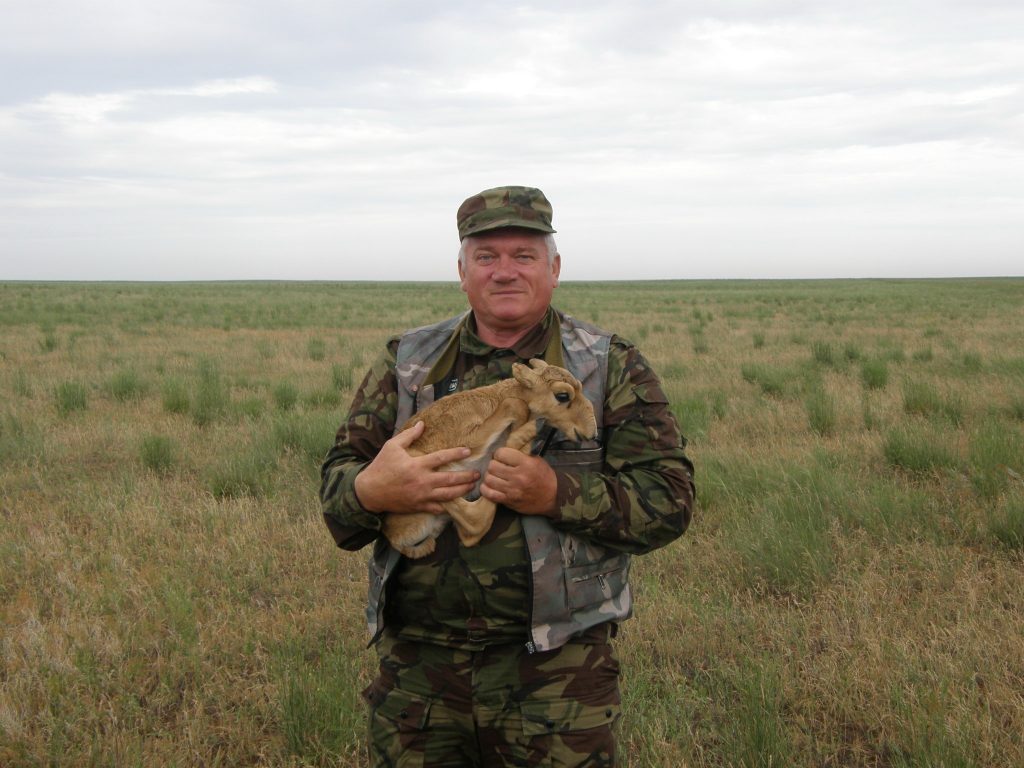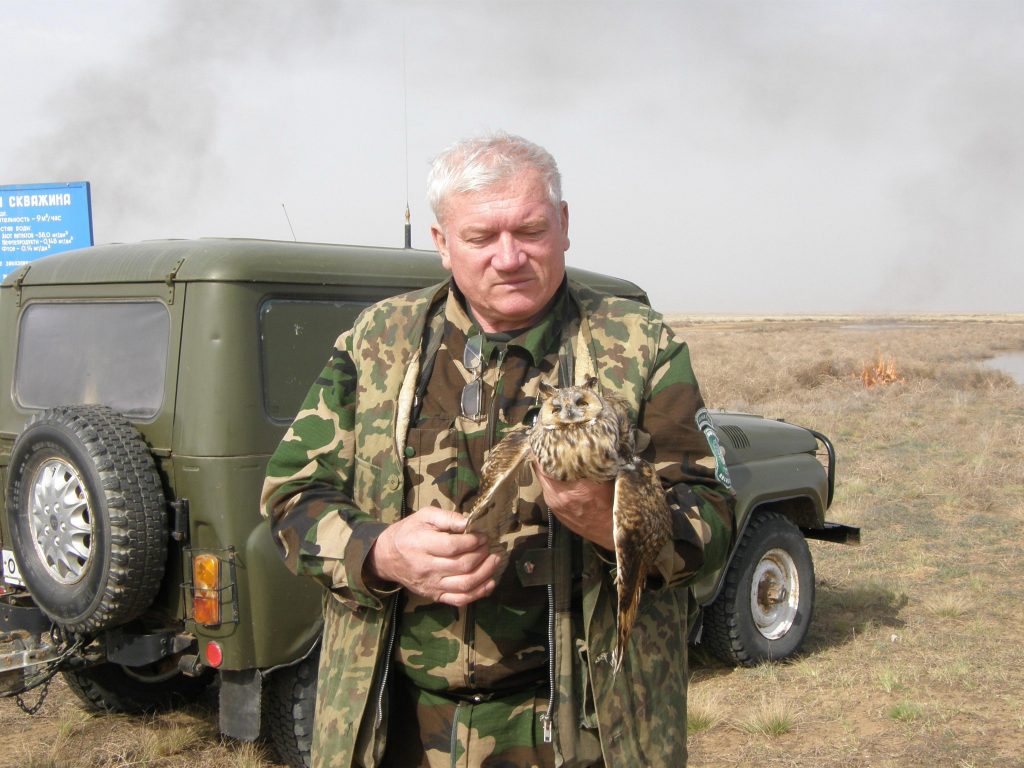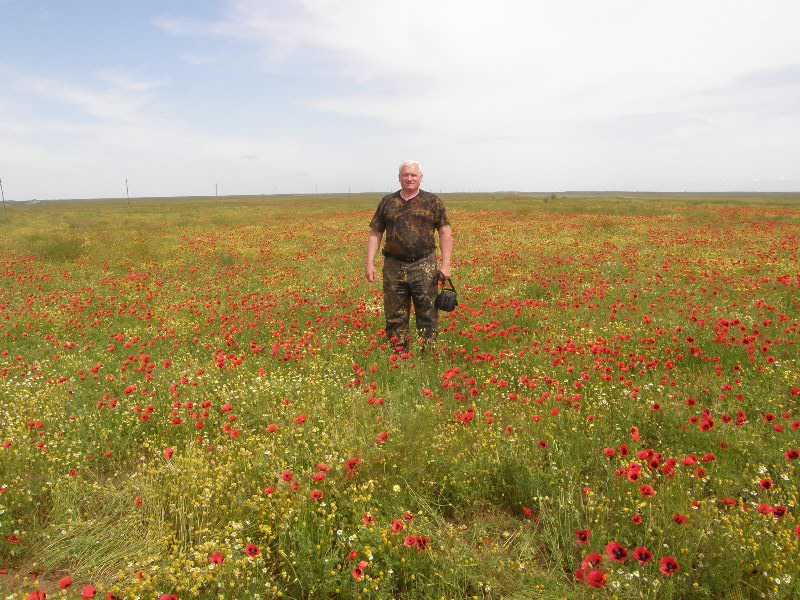3 October 1952 – 10 July 2018
The article was published in Saiga News #24
Early in the morning of 10 July 2018, the heart of Anatoly Vasilyevich Khludnev, a person infinitely dear to all of us, stopped beating. It is hard to believe that the big and good heart of this wonderful man, who, it seemed, would live a very long life, stopped suddenly, making everyone acquainted with Anatoly Vasilyevich utterly lonely.

When he finished his military service, to which he dedicated the whole of his adult life, Anatoly Vasilyevich retired but continued to defend his Motherland, this time as the protector of wildlife in his native Astrakhan Region. He was appointed the first director of the
Like a true commander, Anatoly Vasilyevich led his small army, sometimes risking his life, to struggle vehemently with the trespassers in the reserve’s territory. The outstanding results he achieved were repeatedly mentioned by the international conservation community. Anatoly Vasilyevich made efforts to launch year-round monitoring of the saiga population in the
In 2013, Khludnev was appointed to a new position as the director of the

There is a bitter feeling of
Anatoly Vasilyevich Khludnev will remain in our memory as he often appears in photographs — a kind and happy man and a true expert, who dedicated a fruitful period of his short life to the conservation of saigas and the wildlife of Astrakhan Region.
Interview with Anatoly Khludnev
Published in Saiga News #17
Anatoly Khludnev, Director of the Stepnoi State Nature Reserve, Astrakhan region. Anatoly’s career was as an officer in the Russian Army, and he is now a retired lieutenant colonel. For the last ten years, he has been devoting all his time and energies to the conservation of this unique steppe antelope in the steppes of the northwestern preCaspian region.
Editor: When did you become interested in saigas for the first time?
A.Kh.: I heard about saigas in my earliest childhood, however, I managed to see them for the first time just by good fortune when I was in the 7th form at school. I remember that day very well. I was part of a group of villagers who were out winter fishing. All of a sudden a group of animals running very fast came in sight on the crest of the hill and all the adults shouted: “Saigas!!!”. I managed to have a good look at these animals, all of them were in Winter dress and the group consisted of about 500 animals. I could see males with horns amongst them.
Editor: When did you begin to work on saiga conservation?
A.Kh.: After I completed my military service in 2000, I was offered a job in saiga protection, as the Director of the Stepnoi Nature Reserve. Having assembled a team of nature protection enthusiasts, we developed proper security for saigas, persistently carried on awareness work among the local population and rigidly controlled any attempted poaching within the Stepnoi Nature Reserve and in the adjacent area.
Editor: What is your usual day like?
A.Kh.: I do not consider myself an armchair worker, so I do my best to do all my paperwork as soon as possible and most of my time is spent out on duty to ensure our

Editor: Can you tell us any interesting story about saiga?
A.Kh.: For sure!!!! There are very many stories but most of all I was amazed by a scene which I saw at the very beginning of my career. One fine day I was an eyewitness to adult saigas’ care for their youngsters. It was in June, in the period of the upbringing of young saigas. A migrating herd was moving through the nature reserve, females were leading the way followed by small saigas o a kindergarten o and 5-6 adult males brought up the rear. These males would not let the youngsters lag behind and get lost; they would carefully lift the tired little things with their noses and took care of them in every way. Later, repeatedly watching such herds, I named such males nannies.
Editor: What are the major problems in your work?
A.Kh.: I consider underfinancing of law enforcement and the lack of interaction with the environmental agencies of the Republic of Kalmykia to be the key problems.

Editor: And how can the impediments in your work be removed?
A.Kh.: I believe that the nature conservation problems are resolvable, but that they should be tackled at the regional level or above, by officials of the Astrakhan region and the Republic of Kalmykia.
Editor: What is the best thing in your work?
A.Kh.: A well-coordinated team where the notions of Honour and Conscience are not empty words!!! Striving by all team members to work with their hearts and souls, each of us, is the way to get results! And for

Editor: What are the prospects for saiga conservation? What should be done in the first place to help this species survive?
A.Kh.: At this moment poaching persists in the Republic of Kalmykia. And if we do not create a specialized Federal squad the future of the Russian saiga population is under serious threat.
Editor: You have been working in the field of nature conservation for more than a decade. What has changed over these years and what are the current trends for conservation?
A.Kh.: Changes have mainly taken place within the Astrakhan region; poaching by the local population has been completely eradicated. Mass poaching by Kalmykian residents has also reduced, yet so far we cannot talk of a complete cessation of saiga poaching in Kalmykia. We managed to stabilize the population at about 20,000 in 2000- 2007. After the Federal unit was disbanded in Kalmykia and the powers for wildlife conservation were passed to regional control, nature protection collapsed. There was practically no protection for nine months in 2008. For this reason, in 2010 the saiga population dropped to 12,000 animals. Currently, the Russian saiga population is no larger than 7,000 animals.
Editore’s note: Based on his achievements at the Stepnoi reserve, Anatoly has just been appointed as Director of the newly created MVolgaȬ Aktiubinsk InterfluveP regional reserve.ȱȱWe wish Anatoliy every success in his new role. His Deputy, Vladimir Kalmykov, who worked with him in setting up the Stepnoi reserve from the beginning, has been appointed as the new Director. We give him all our
